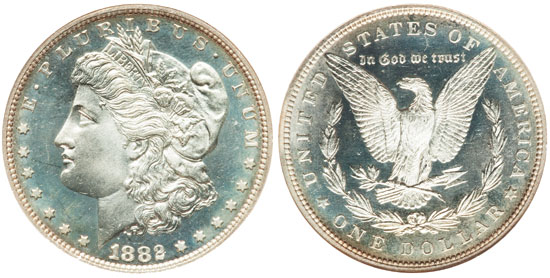The Philadelphia Mint struck proof versions of the Morgan Dollar for each year of the series from 1878 to 1904 (Buy on eBay). The mintages for these issues ranged from the high hundreds to just above one thousand pieces. A number of branch mint proof issues exist, which were struck in extremely small numbers. Additionally, proof and proof-like coins were struck for the final year of the series in 1921.

The quality of proof coins produced by the Philadelphia Mint had greatly improved by the time the Morgan Dollar series had launched. As a result, most proofs will feature full strikes with reflective fields and outstanding eye appeal. Many will also feature frosted design elements. Depending on the extent of the contrast between the devices and the fields, the major grading services can designate a Proof Morgan Dollar as cameo or deep cameo. For certain years, coins with cameo contrast represent a distinct minority and carry strong premiums.
The most famous Proof Morgan Dollar is without a doubt the 1895 Proof Morgan Dollar. Even though United States Mint records indicate that 12,000 circulation strikes were made at the Philadelphia Mint none are known to exist, leaving the numismatic community with the extremely limited number of 880 proof pieces that were produced. This is neither an extremely high nor low number among proofs, however because of the lack of business strikes, demand and premiums for the issue coins are high, especially for pieces that show pristine fields and cameo contrast. There are also a number of circulated pieces known, which are still recognized as proofs simply because no circulation strike has ever been identified of this date.
Branch mint proof coins were struck at the New Orleans and Carson City Mint facilities for certain years of the series. These proofs were typically struck to commemorate special occasions and have mintages of less than a dozen pieces. Some examples include the 1879-O struck to commemorate the re-opening of the New Orleans Mint; the 1883-O struck to mark the founding of Tulane University; and the 1893-CC struck to commemorate the closing of the Carson City Mint. Each of these issues are considered rarities and examples have sold for six-figure prices when brought to market.
By the time Morgan Dollar production had restarted in 1921, the production of proof coinage at the Philadelphia Mint had ceased due to declining sales over the past decade. However, the Mint would strike proof and proof-like versions of the Morgan Dollar for two prominent coin dealers. Farran Zerbe, a numismatist involved in the creation of the Peace Dollar, had requested examples of the final Morgan Dollars to display at a coin show. The Mint would strike between 20 and 200 so-called “Zerbe Proofs” to fulfill his request. These coins were struck with polished dies but on regular planchets, leading most numismatists to consider these coins special strikes with proof-like qualities. A smaller group of 10 to 15 so-called “Chapman Proofs” were struck for coin dealer Henry Chapman under unknown circumstances. These coins are generally classified as true proofs due to the mirrored surfaces, extremely strong strikes, and squared rims.
< GSA Morgan Dollars | PL & DMPL Morgan Dollars >

